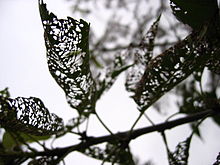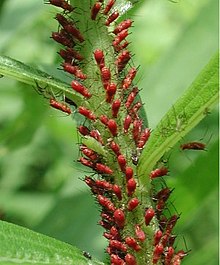Apples/Pests and diseases
The trees are susceptible to a number of fungal and bacterial diseases and insect pests. Many commercial orchards pursue an aggressive program of chemical sprays to maintain high fruit quality, tree health, and high yields. A trend in orchard management is the use of organic methods. These use a less aggressive and direct methods of conventional farming. Instead of spraying potent chemicals, often shown to be potentially dangerous and maleficent to the tree in the long run, organic methods include encouraging or discouraging certain cycles and pests. To control a specific pest, organic growers might encourage the prosperity of its natural predator instead of outright killing it, and with it the natural biochemistry around the tree. Organic apples generally have the same or greater taste than conventionally grown apples, with reduced cosmetic appearances.

A wide range of pests and diseases can affect the plant; three of the more common diseases/pests are mildew, aphids and apple scab.
- Mildew: which is characterized by light grey powdery patches appearing on the leaves, shoots and flowers, normally in spring. The flowers will turn a creamy yellow colour and will not develop correctly. This can be treated in a manner not dissimilar from treating Botrytis; eliminating the conditions which caused the disease in the first place and burning the infected plants are among the recommended actions to take.

- Aphids: There are five species of aphids commonly found on apples: apple grain aphid, rosy apple aphid, apple aphid, spirea aphid and the woolly apple aphid. The aphid species can be identified by their colour, the time of year when they are present and by differences in the cornicles, which are small paired projections from the rear of aphids. Aphids feed on foliage using needle like mouth parts to suck out plant juices. When present in high numbers, certain species may reduce tree growth and vigor.[1]
- Apple scab: Symptoms of Scab are olive-green or brown blotches on the leaves.[2] The blotches turn more brown as time progresses. Then brown scabs on the fruit. The diseased leaves will fall early and the fruit will become increasingly covered in scabs - eventually the fruit skin will crack. Although there are chemicals to treat Scab, their use might not be encouraged as they are quite often systematic, which means they are absorbed by the tree, and spread throughout the fruit.[2]
Among the most serious disease problems are fireblight, a bacterial disease; and Gymnosporangium rust, and black spot, two fungal diseases.[1]
Young apple trees are also prone to mammal pests like mice and deer, which feed on the soft bark of the trees, especially in winter.
References
edit- ↑ a b Coli, William; et al. "Apple Pest Management Guide". University of Massachusetts Amherst. Retrieved 3 March 2008.
{{cite web}}: Explicit use of et al. in:|author=(help); Unknown parameter|dateformat=ignored (help) - ↑ a b "How To Deal With Scab". GardenAction. Retrieved 3 March 2008.
{{cite web}}: Unknown parameter|dateformat=ignored (help)